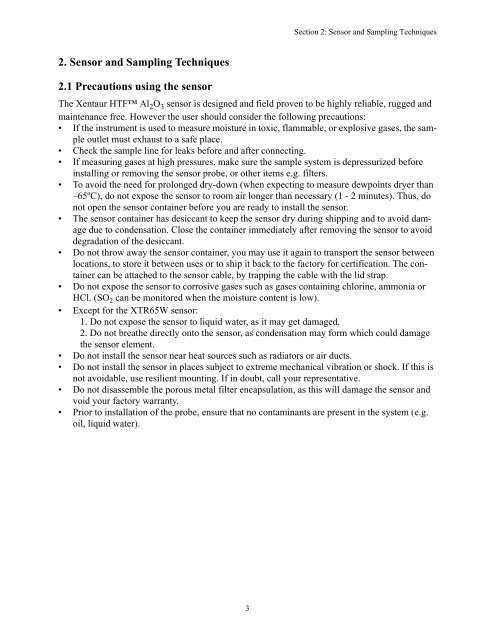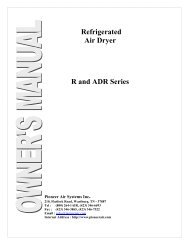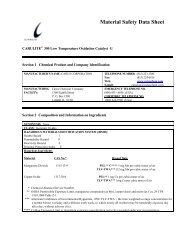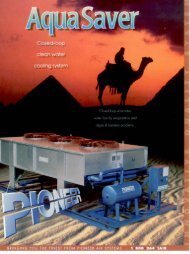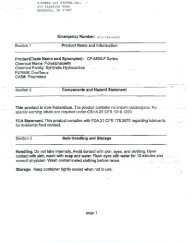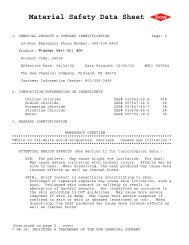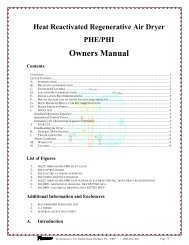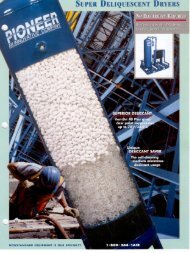Section 2: Sensor and Sampling Techniques2. Sensor and Sampling Techniques2.1 Precautions using the sensorThe Xentaur HTF Al 2 O 3 sensor is designed and field proven to be highly reliable, rugged andmaintenance free. However the user should consider the following precautions:• If the instrument is used to measure moisture in toxic, flammable, or explosive gases, the sampleoutlet must exhaust to a safe place.• Check the sample line for leaks before and after connecting.• If measuring gases at high pressures, make sure the sample system is depressurized beforeinstalling or removing the sensor probe, or other items e.g. filters.• To avoid the need for prolonged dry-down (when expecting to measure dewpoints dryer than–65ºC), do not expose the sensor to room air longer than necessary (1 - 2 minutes). Thus, donot open the sensor container before you are ready to install the sensor.• The sensor container has desiccant to keep the sensor dry during shipping and to avoid damagedue to condensation. Close the container immediately after removing the sensor to avoiddegradation of the desiccant.• Do not throw away the sensor container, you may use it again to transport the sensor betweenlocations, to store it between uses or to ship it back to the factory for certification. The containercan be attached to the sensor cable, by trapping the cable with the lid strap.• Do not expose the sensor to corrosive gases such as gases containing chlorine, ammonia orHCl. (SO 2 can be monitored when the moisture content is low).• Except for the XTR65W sensor:1. Do not expose the sensor to liquid water, as it may get damaged.2. Do not breathe directly onto the sensor, as condensation may form which could damagethe sensor element.• Do not install the sensor near heat sources such as radiators or air ducts.• Do not install the sensor in places subject to extreme mechanical vibration or shock. If this isnot avoidable, use resilient mounting. If in doubt, call your representative.• Do not disassemble the porous metal filter encapsulation, as this will damage the sensor andvoid your factory warranty.• Prior to installation of the probe, ensure that no contaminants are present in the system (e.g.oil, liquid water).3
<strong>XDT</strong> User’s <strong>Manual</strong>2.2 Sensor Technical SpecificationsType: ..................................Hyper Thin Film HTF high capacitance Al 2 O 3 .Dewpoint range:.................XTR-100: -148°F to +68°F (-100°C to +20°C)XTR-65: -85°F to +68°F (-65°C to +20°C).XTR-60: (-60°C to +20°C)XTR-LQ: for use in liquidsCapacitance:.......................15nF to 200nF.Accuracy:...........................±5.5°F (±3°C) refer to appendix M for accuracy expressed in other units of measure.Repeatability:.....................±0.9°F (±0.5°C).Response time:...................refer to Dewpoint Response time analysis in Appendix G.Operating Temperature: .....14°F to 158°F (-10°C to +70°C), non-condensingStorage Temperature: .........-40°F to+176°F (-40°C to +80°C), non-condensingSample Flow range: ...........(linear velocity @ 1ATM): Static to 100m/s.Enclosure: ..........................encapsulated in 100µ sintered stainless steel.Calibration method: ...........Highly uniform sensors calibrated at low dewpoint and SpanCheck, sensor saturates at dewpointabove +68°F (+20°C). NIST/NPL traceable multi-point factory calibration available optionally.Pressure operating range:...Standard:500 PSI (34 bar).Optional:5,000 PSI (340 bar).Mechanical connections:....14mm x 1.25mm sparkplug threads, and ¾”-16 threads, standardOptional configurations: G1/2, 1/2”NPT, 5/8”-18 and othersElectrical connections:.......Female BNC connector.Sensor signal cable: ...........RG58 coaxial cable, or for lengths greater than 100’ RG6 coaxial cable, max 17,000pF.Approvals/Classifications:.CE for electromagnetic compatibility, accredited laboratory tested and certifiedHazardous Locations:UL Class I,II, Division 1, Groups A,B,C,D,E,F,G intrinsically safe when installed per drawings<strong>XDT</strong>.00.D.6001 or <strong>XDT</strong>.00.D.6002 or <strong>XDT</strong>.00.D.6003DEMKO 05 ATEX 0505798X II 1 G EEx ia IIC T6 -20°C≤Ta≤+60°C Intrinsically Safe wheninstalled per drawing <strong>XDT</strong>.00.D.60012.3 Sensor Installation & Sampling TechniquesKeep in mind that the moisture content at the sensor is not only due to the moisture of the gasbeing measured, but also due to desorption of water from tubing, trapped moisture (at the interconnectionpoints, valves, filters and other hygroscopic materials in the system), leaks in the system,and others. Thus the measurement may vary from the expectation, and therefore care shouldbe taken in choosing the sampling technique utilized in the measurement. Factors such as gaspressure, flow rate, materials of construction, length and diameter of tubing, number of interconnectingfittings, dead space in tubing and manifolds; will influence the measurement value andresponse time.The high capacitance HTF sensors can be installed either directly in the line to be sampled (insitu),or in a slip stream of a sample system (extractive).To assure a long and accurate performance of the sensor, it should be protected from contaminantssuch as liquids (water, oil etc.), and particulates. The sintered stainless steel sensor encapsulationprotects from particulates larger than 100 microns, finer particulates (e.g. from degraded desiccantor rust) should be filtered with a particulate filter with suitable capability, do not use hygroscopicfilter materials. Refer to Sample Gas Filter Considerations Appendix H.4


